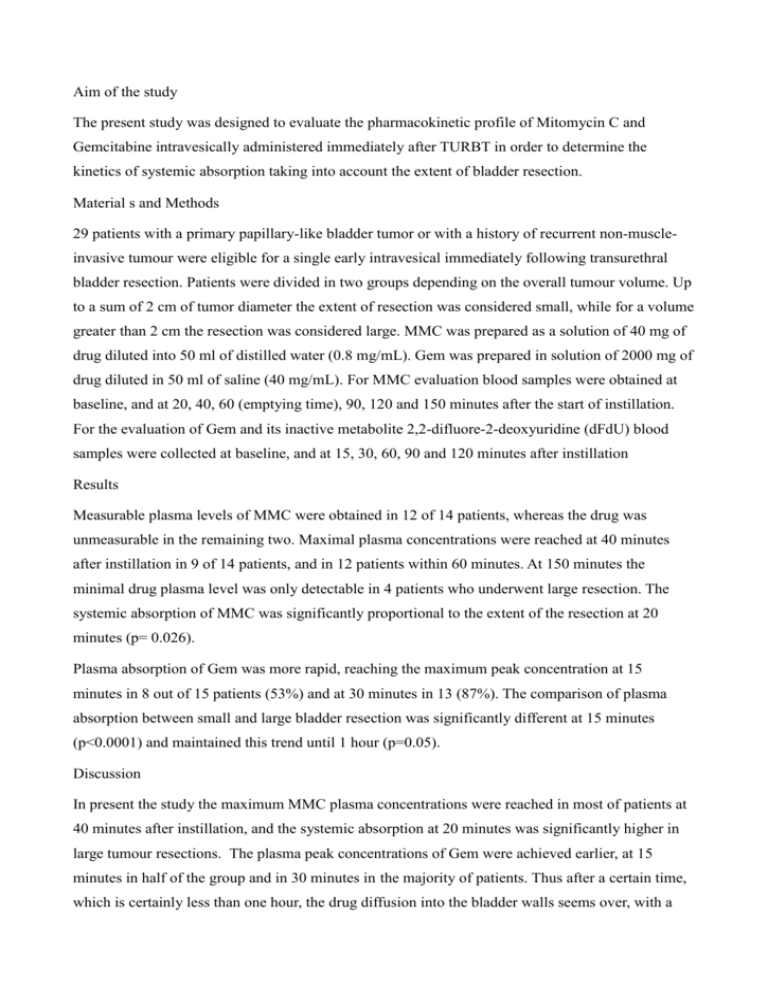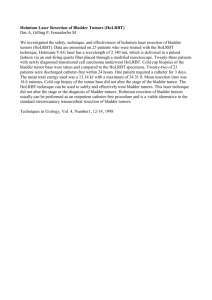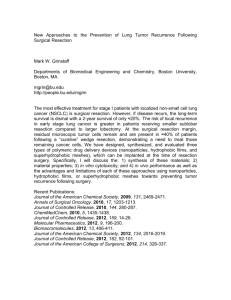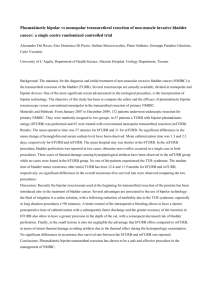Aim of the study The present study was designed to evaluate the
advertisement

Aim of the study The present study was designed to evaluate the pharmacokinetic profile of Mitomycin C and Gemcitabine intravesically administered immediately after TURBT in order to determine the kinetics of systemic absorption taking into account the extent of bladder resection. Material s and Methods 29 patients with a primary papillary-like bladder tumor or with a history of recurrent non-muscleinvasive tumour were eligible for a single early intravesical immediately following transurethral bladder resection. Patients were divided in two groups depending on the overall tumour volume. Up to a sum of 2 cm of tumor diameter the extent of resection was considered small, while for a volume greater than 2 cm the resection was considered large. MMC was prepared as a solution of 40 mg of drug diluted into 50 ml of distilled water (0.8 mg/mL). Gem was prepared in solution of 2000 mg of drug diluted in 50 ml of saline (40 mg/mL). For MMC evaluation blood samples were obtained at baseline, and at 20, 40, 60 (emptying time), 90, 120 and 150 minutes after the start of instillation. For the evaluation of Gem and its inactive metabolite 2,2-difluore-2-deoxyuridine (dFdU) blood samples were collected at baseline, and at 15, 30, 60, 90 and 120 minutes after instillation Results Measurable plasma levels of MMC were obtained in 12 of 14 patients, whereas the drug was unmeasurable in the remaining two. Maximal plasma concentrations were reached at 40 minutes after instillation in 9 of 14 patients, and in 12 patients within 60 minutes. At 150 minutes the minimal drug plasma level was only detectable in 4 patients who underwent large resection. The systemic absorption of MMC was significantly proportional to the extent of the resection at 20 minutes (p= 0.026). Plasma absorption of Gem was more rapid, reaching the maximum peak concentration at 15 minutes in 8 out of 15 patients (53%) and at 30 minutes in 13 (87%). The comparison of plasma absorption between small and large bladder resection was significantly different at 15 minutes (p<0.0001) and maintained this trend until 1 hour (p=0.05). Discussion In present the study the maximum MMC plasma concentrations were reached in most of patients at 40 minutes after instillation, and the systemic absorption at 20 minutes was significantly higher in large tumour resections. The plasma peak concentrations of Gem were achieved earlier, at 15 minutes in half of the group and in 30 minutes in the majority of patients. Thus after a certain time, which is certainly less than one hour, the drug diffusion into the bladder walls seems over, with a final low systemic absorption. The present study showed the low plasma absorption of two drug immediately administered after bladder resection. This evidence was achieved either in small or large tumour resection, thus including larger exposure of the resected bladder wall to the drug contact. Toxicity was lower for MMC group, while in Gem group grade 2 leucopenia and gastrointestinal were detected in two patients. Conclusion In conclusion, this study, showed that an early postoperative instillation of MMC and Gem are generally safe also after large tumour resection, even if the check of bladder wall perforation is demanding. The systemic drug absorption is generally lower and consistent in the first half of the instillation interval time. That evidence suggests that the historic notion to maintain the drug into the bladder as long as possible may not be scientifically justified.





